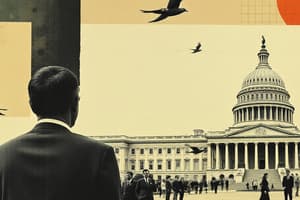Podcast
Questions and Answers
Taxation is a tool the Federal Reserve uses to implement federal monetary policy.
Taxation is a tool the Federal Reserve uses to implement federal monetary policy.
False (B)
A single taxpayer may deduct up to $450,000 in capital gains from the sale of a primary residence.
A single taxpayer may deduct up to $450,000 in capital gains from the sale of a primary residence.
False (B)
The discount rate is the interest rate the Federal Reserve charges member banks who borrow funds to cover shortfalls.
The discount rate is the interest rate the Federal Reserve charges member banks who borrow funds to cover shortfalls.
True (A)
Economic growth that is very fast is usually accompanied by deflation.
Economic growth that is very fast is usually accompanied by deflation.
What is the primary tool the Federal Reserve uses to influence interest rates?
What is the primary tool the Federal Reserve uses to influence interest rates?
What is the term for the interest rate banks charge each other for overnight, unsecured loans?
What is the term for the interest rate banks charge each other for overnight, unsecured loans?
What is the primary function of the Federal Reserve?
What is the primary function of the Federal Reserve?
If the Federal Reserve wants to decrease interest rates, what actions should they take?
If the Federal Reserve wants to decrease interest rates, what actions should they take?
Which entity is primarily responsible for executing the federal government's fiscal policy?
Which entity is primarily responsible for executing the federal government's fiscal policy?
What occurs when the federal government's spending exceeds its revenue in a given year?
What occurs when the federal government's spending exceeds its revenue in a given year?
What effect does the federal government selling interest-bearing securities to investors typically have?
What effect does the federal government selling interest-bearing securities to investors typically have?
How does the deductibility of home mortgage interest generally affect taxpayers?
How does the deductibility of home mortgage interest generally affect taxpayers?
For a married couple filing jointly, what is the maximum capital gain exclusion from the sale of a principal residence, assuming the requirements are satisfied?
For a married couple filing jointly, what is the maximum capital gain exclusion from the sale of a principal residence, assuming the requirements are satisfied?
What is the primary way a lender assesses the likelihood of a borrower failing to repay the loan?
What is the primary way a lender assesses the likelihood of a borrower failing to repay the loan?
Which scenario would MOST likely result in lower interest rates?
Which scenario would MOST likely result in lower interest rates?
Which form of investment allows the owner to realize a return through appreciation, rents, or both?
Which form of investment allows the owner to realize a return through appreciation, rents, or both?
For which type of property are depreciation deductions available?
For which type of property are depreciation deductions available?
Which of the following BEST describes a debt investment?
Which of the following BEST describes a debt investment?
What is the primary method by which the U.S. Treasury finances a federal deficit?
What is the primary method by which the U.S. Treasury finances a federal deficit?
What is the relationship between risk and potential yield in investments?
What is the relationship between risk and potential yield in investments?
Flashcards
Federal Deficit
Federal Deficit
The difference between the government's total revenue (from taxes) and its total spending in a given year.
Discount Rate
Discount Rate
The interest rate that the Federal Reserve charges banks for short-term emergency loans when they can't meet reserve requirements.
Federal Funds Rate
Federal Funds Rate
The target interest rate that banks charge each other for the overnight lending of reserves. It's influenced by the Federal Reserve's open market operations.
Reserve Requirement
Reserve Requirement
Signup and view all the flashcards
Inflation
Inflation
Signup and view all the flashcards
Yield
Yield
Signup and view all the flashcards
Debt Investment
Debt Investment
Signup and view all the flashcards
Ownership Investment
Ownership Investment
Signup and view all the flashcards
Risk of Default
Risk of Default
Signup and view all the flashcards
Federal Budget Deficit
Federal Budget Deficit
Signup and view all the flashcards
Impact of Government Borrowing on Interest Rates
Impact of Government Borrowing on Interest Rates
Signup and view all the flashcards
Federal Monetary Policy
Federal Monetary Policy
Signup and view all the flashcards
Home Mortgage Interest Deduction
Home Mortgage Interest Deduction
Signup and view all the flashcards
Home Sale Capital Gains Exclusion
Home Sale Capital Gains Exclusion
Signup and view all the flashcards
Open Market Operations
Open Market Operations
Signup and view all the flashcards
What is the Discount Rate used for?
What is the Discount Rate used for?
Signup and view all the flashcards
What is the risk of default?
What is the risk of default?
Signup and view all the flashcards
What is a debt investment?
What is a debt investment?
Signup and view all the flashcards
What is yield?
What is yield?
Signup and view all the flashcards
What is a federal budget deficit?
What is a federal budget deficit?
Signup and view all the flashcards
What is an ownership investment?
What is an ownership investment?
Signup and view all the flashcards
Study Notes
Federal Fiscal and Monetary Policy Learning Objectives
- Students should be able to recall two ways the federal government influences borrowing costs.
- Students should be able to define fiscal policy and the branches of government that implement it.
- Students should be able to describe how government spending and federal deficits are financed through debt.
- Students should be able to explain how taxation is used to implement social policy regarding real property.
- Students should be able to summarize the historical reasons for government regulation of depository institutions.
- Students should be able to outline the organization of the Federal Reserve System.
- Students should be able to discuss the relationship between Federal Reserve actions, inflation, and the health of the economy.
- Students should be able to list the tools used by the Federal Reserve to implement monetary policy.
Suggested Lesson Plan
- Students review the previous chapter on finance and investment using exercise 2.1.
- Students receive a brief overview and review the learning objectives for Chapter 2.
Government Influences on Finance
- The federal government influences real estate finance by impacting the cost of mortgage funds.
- Market interest rates reflect the cost of borrowing, which is affected by supply and demand.
- Fiscal policy (spending and debt financing, and taxation) and monetary policy impact the cost of borrowing.
Fiscal Policy
- Fiscal policy is determined by legislative and executive branches, carried out by the US Treasury.
- A federal deficit occurs when government spending exceeds revenue.
- To cover deficits, the government sells interest-bearing securities to investors.
- Some economists believe federal deficits have little effect on interest rates while others believe deficits increase interest rates.
Taxation
- Taxation affects mortgage rates by influencing the amount of money available for lending or investment.
- Tax exemptions, deductions, and exclusions affect mortgage demand.
- Interest on home mortgages is deductible, reducing tax obligations; interest on home equity loans is deductible if the funds are used for substantial home improvements but not if the total loan exceeds $750,000, beginning in 2018.
- The gain from selling a primary residence up to a certain amount is potentially tax-excluded ($250,000 for individuals, $500,000 for couples).
- Investors may take depreciation deductions.
Monetary Policy
- Federal monetary policy involves controlling the money supply, executed by the Federal Reserve System.
- Banks were first regulated in 1863 with the National Bank Act, which laid out supervisory procedures.
- The Federal Reserve System was established in 1913 and 1916.
- The Federal Reserve acts as a lender of last resort, supplying short-term loans to banks facing liquidity issues.
- The Federal Reserve, formed as a decentralized system with 12 regional banks, has evolved into a crucial economic player.
Tools for Implementing Monetary Policy
- Reserve requirements: Banks must maintain a percentage of their deposits. An increase in reserves reduces the ability of banks to lend and increases interest rates; a decrease has the opposite effect.
- Interest Rates: The Federal Reserve controls the federal funds rate (rate banks charge each other for loans) and the discount rate (rate Fed charges banks for loans). Raising interest rates can curb inflation whilst lowering interest rates can stimulate economic activity by making borrowing cheaper.
- Open Market Operations: Buying or selling government securities to adjust the money supply. Buying securities increases the money supply and lowers interest rates; selling decreases the money supply and raises rates.
Studying That Suits You
Use AI to generate personalized quizzes and flashcards to suit your learning preferences.




